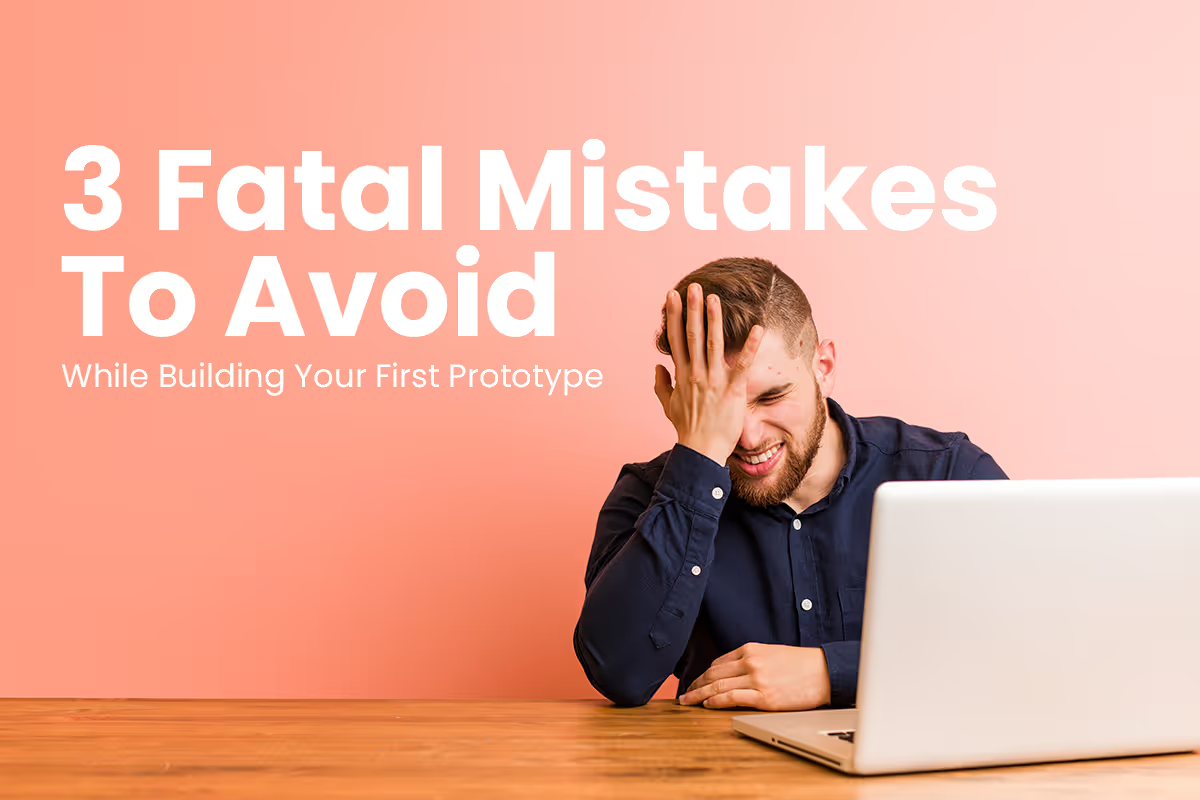3 Fatal Mistakes To Avoid While Building Your First Product Prototype

Businesses stumble upon many Do’s and Don'ts while making plans, building product prototypes, and more. At the outset, it looks like a lot of information to either work upon or consider, but with the immense pressure from investors or in a rush to build and deliver the prototype or to stay ahead of the game, in case they have a competitor with a similar concept, the Do’s and Don'ts get overlooked.
Also, the credibility of the Do’s and Don'ts is always under the scanner. But, at the time of user acceptance tests on prototypes, businesses get overwhelmed with the number of missing or moving pieces they never accounted for. This type of unaccounted errors usually brings in the downfall for startups that fail in the first couple of years of inception, even when they initially had a great concept and buy-in from major investors.
Ideally, to ward off any discrepancies, businesses should chalk down a framework for building prototypes so that they can adhere to some standards. In this article, we will discuss the most common pitfalls to avoid while building your first product prototype.
Evaluate and do course correction against the below-mentioned criteria and steer clear from making the three fatal mistakes that usually contribute to the failure of early-stage startups.
1) Are you obsessed with the word ‘for the millennials’?
The world is going gaga over the word ‘millennials’, and every brand is trying to position itself as for the millennials. When it comes to technology that is aimed at the masses, millennials become paramount as people try to relate themselves with the tech gadgets they wear or possess. So, brands have been trying to target Gen X or GenY while they dish out new offerings in the tech space.
In the process of churning out something for the millennials, you should not compromise on the core functionality of the product. The prototype has to be built in the same way.
In another scenario, developers add uber-cool features to the prototype but they can’t replicate the same when it’s produced on a mass scale. Many factors such as commercial viability, ease of production, logistics, and delivery come into the picture.
For instance, a mobile phone can look flashy and glitzy but it should serve the core purpose of communication. Just to make it look catchy and made for the millennials, you should not compromise on the essential features.
If you are building an e-learning website/product, the normal tendency is to make the whole interface jazzy with appealing colors and navigation so that the learner stays there for a while and explores all the courses, and subscribes to what is necessary.
But what happens if your core is lost amid all the jazz. Then you try to cover the cracks with all the glitz. This can be related to all the product prototypes where developers try to compromise value for something cool.
2) Do you prefer predictions to predictive analytics?
Are you the kinds who leave their luck to heaven? It may not work while building a product prototype. You can predict so many things, so many outcomes, and build a roadmap for your product and design the prototype accordingly.
However, these are flimsy and won’t stand for the test of time. Make way for predictive analysis, which trumps all the predictions. Predictive analytics includes a string of statistical techniques from machine learning, data mining, and predictive modeling, that analyze various facts to draw predictions about unknown occurrences.
This helps in building your first product prototype and makes it immune to any unforeseen events in the future. Predictive models capture the association of various factors and help developers with risk assessment or potential mapping that aids their decision-making. Avoid the fatal mistake of predicting the outcomes and switch to predictive analytics. That’s the best thing to resort to while building your first prototype.
3) Do you overlook user requirements?
It is said that customers are kings and queens. Yes, they are and whatever you are building should be aligned to their requirements. While building and testing the prototype have clear goals based on user requirements, or else it will be like moving to a new city without your GPS or Google maps turned on.
Setting goals will add a purpose to your testing and remind you that you are always in sync with the user requirements. Don’t make testing akin to ticking off some boxes on the to-do list. Then you will be in a fix when your first prototype is out and will question whether it can help the users solve any of their problems, or how better it can supplement their activities.
Run some use cases
Scenario # 1
You have added a feature to activate the ‘disappearing messages’ feature in the messenger. Now you want to know whether users can find it.
This is to understand whether the user can navigate to this super cool feature easily or not? Ask questions such as:
Was it difficult for you to find this feature?
Where is this feature lying on the interface and how many screens the user has to move to get there?
Is this feature incorporated based on the user feedback or you felt it’s cool as every other messenger service is having it?
Ask these questions and you are hitting the right chord.
Scenario # 2
You want the customers to sign up for a service or book an appointment to move further in their journey, and for this task, you have added a sign-up button.
This is a clear case of a call to action - CTA. Ask questions such as:
Will I click this button if I am a customer?
Does it sound mundane and boring?
Is the CTA clear or the user has to go through so much clutter to do an action?
Conclusion
While building your first product prototype ensure that you don’t fall into the aforesaid traps - staying cool, predicting outcomes, and not understanding user requirements. These can have lasting effects on your product journey and prove detrimental in the long run.
To reiterate some suggestions, don’t build your prototype on the grounds of making it just for the millennials. What you think works well may not be well received by your users. Secondly, put the right predictive analytics in place to safeguard your prototype.
Lastly, listen to your users, understand their requirements, and build your prototype. You must be building your first prototype but this checklist will help you build a solid product in the future.
Do you have a great product idea? Then it’s time to test its potential. Reach out to Fission Labs’ engineering team with rich experience in building new products Proof of Concept, Product Prototypes, and Minimum Viable Product. Our PoC and MVP services are designed with the intention to meet business goals. Click here for a free consultation from the product expert.



